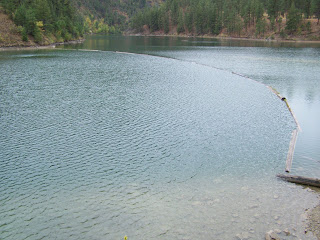The late Carl Trautman
Trail Blazing
Rising early we would drive past Glenn Fir and then turn off the Chute Lake Road to the parking lot at the southern side of the Okanagan Mountain Park. Each morning the three of us would set out armed with chainsaw, axe, picks and shovels to establish a trail into Baker Lake. This was already roughly flagged and took advantage of several sections of old logging roads.
At the parking lot there was already a footbridge over the creek and an outhouse already established. Work progress very swiftly as we first followed and old road, but soon we angled off through the bench land and through a little denser stand before hitching up to another old road. So it went some easy sections and other sections that required much more cutting and digging. After a week we were far enough from the vehicle that we stashed the gear in the evenings taking only the gas and oil cans to refill before the next morning.
It was good physical work with the added benefit of all that clear fresh air and the pleasure of being in the company of cheeky squirrels and chipmunks. Ruffle grouse would whistle and scurry around before bursting forth in a noisy low weaving flight. The huge blue grouse on the other hand would thunder up into the trees well ahead of us. Deer track were everywhere, but usually we only caught a glimpse or two of them in distance.
One morning we came across a deer carcass, a fresh cougar kill in the middle of that trail. We dragged it off to the side and continued on our way. Each morning for the next four days we dragged the carcass off and each evening the cougar would stubbornly drag it back to that specific spot on the trail. In the end it was the smaller scavengers cleaning and spreading the bones around that settled our little dispute.
Eventually we completed the first part of the project and reached Baker Lake and the little cabin that would be a cozy shelter for overnight hikers. Since the weather was still holding we then back tracked and began a side trail towards Divide Lake. Unfortunately we were not able to complete this trail before the snows flew.
Since that date more trails have been laid out and we had some great hikes here before the Okanagan Mountain fire. The trail had been completed to Divide Lake an here too there was a very pleasant cabin for shelter. One of my projects for the coming year will be to check out these trails and to see the effects the fire has had on them.
In the past I’ve met hikers from as far away as Germany and Australia on these trails. Sharing the hills brings both an awareness of the beauty of our back country and adds to the economic health of our region. This awareness is perhaps one of the best protections our natural habitat has in its favour. Perhaps we should consider a Trail Blazer Club to mark and maintain trails and access into these beautiful spots. Why wait until we loose access as we nearly did at the Skaha Bluffs.




















